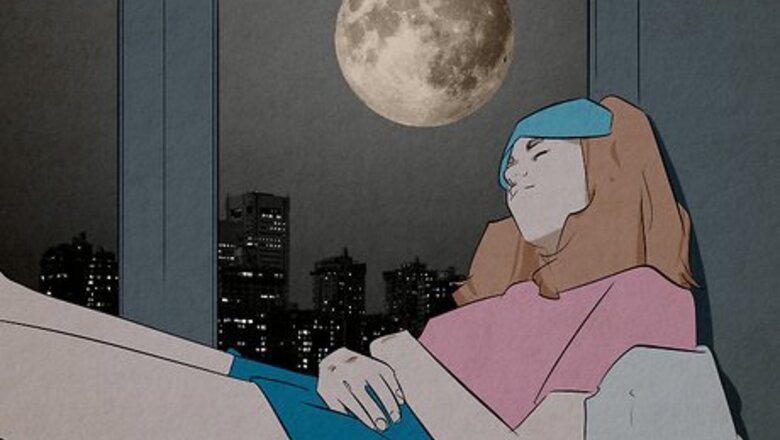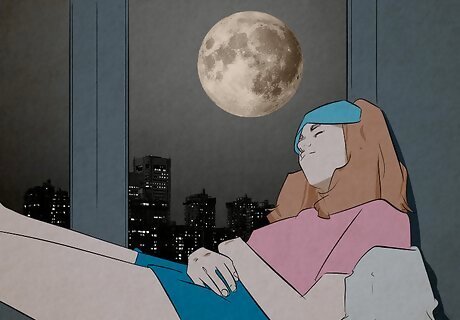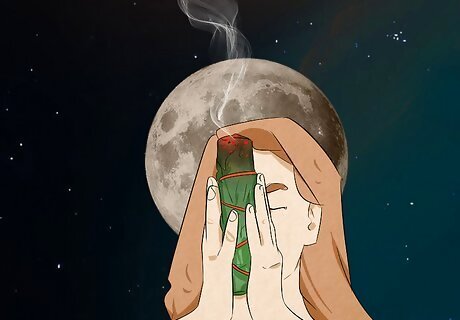
views
- A red moon cycle refers to someone who gets their period on the full moon and ovulates during the new moon.
- If your period syncs with the full moon, it could be a sign to embrace your passionate, healing side and use your creative energy to empower others.
- Spend time in nature or perform a full moon ritual, like taking a moon bath, to sync with the moon’s cycles.
What is a red moon cycle?

A red moon cycle is a menstrual cycle that begins on the full moon. This means you get your period when the moon is full and enter ovulation during a new moon. Red moon cycles are believed to be less common because the full moon is usually associated with fertility and ovulation, while the new moon represents the start of a new cycle, or menstruation. The four phases of a red moon cycle are: Menstruation or bleeding phase (full moon) Follicular or pre-ovulation phase (waning moon) Ovulation (new moon) Luteal or premenstrual phase (waxing moon)
Red Moon Cycle Spiritual Meaning

Red moon cycles are associated with creativity, passion, and healing. When you get your period during the full moon, you’re infused with inner strength, inspiration, and self-reflection. Red moon cycles are also associated with leadership. Everything you learn and experience helps to empower you from within, which you can use to empower others around you. During a full moon, you may feel more motivated than ever to complete projects and implement new ideas. Historically, those who experience a red moon cycle are believed to be healers, priestesses, witches, or medicine women, focused on channeling their creative energy inward.
White, Pink, and Purple Moon Cycles

White moon cycle Those who get their period on the new moon follow the White Moon Cycle. This cycle is thought to be the most common because your ovulation phase aligns with the full moon, the earth’s most fertile period. Spiritual Significance: You may feel a desire to start a family, connect with your community, or nurture those around you. The four phases of a white moon menstrual cycle are: Menstruation or bleeding phase (new moon) Follicular or pre-ovulation phase (waxing moon) Ovulation (full moon) Luteal or premenstrual phase (waning moon)

Pink moon cycle If you have a pink moon cycle, you get your period during the waxing crescent and gibbous moon phases. Spiritual Significance: You may menstruate during a pink moon during a time of transition and growth. Like the moon, you’re on your way to reaching your fullest potential. The four phases of a pink moon menstrual cycle are: Menstruation or bleeding phase (waxing moon) Follicular or pre-ovulation phase (full moon) Ovulation (waning moon) Luteal or premenstrual phase (new moon)

Purple moon cycle Those with a purple moon menstruation cycle get their period during the waning crescent and gibbous moon phases. Spiritual Significance: A purple moon cycle often symbolizes a time of rest, reflection, and preparation for a new life phase. The four phases of a purple moon menstrual cycle are: Menstruation or bleeding phase (waning moon) Follicular or pre-ovulation phase (new moon) Ovulation (waxing moon) Luteal or premenstrual phase (full moon)
Lunar Cycles & Menstruation

The phases of the moon might affect your menstrual cycle. Some studies have found that humans are sensitive to the moon’s cycle. However, these studies aren’t conclusive, and scientists aren’t sure why synchronizing with the lunar cycle would be beneficial or possible. A 2021 study found that the frequency and phases of menstrual cycles might be controlled by the moon’s phases. Earlier studies have shown that 22 to 32% of young women have 29.5-day cycle lengths and have their period on the full moon. The lunar cycle lasts 29.5 days, while the average menstrual cycle lasts around 21 to 35 days. However, a 2013 study found that the moon’s phases don’t sync with menstrual cycles at all.

Syncing your cycle with the lunar cycle doesn’t have any known benefits or risks. There's not any evidence that indicates if it's a good or bad thing to sync your menstrual cycle with the phases of the moon. All that matters is that you have a healthy, consistent cycle each month. The typical menstrual cycle can range from 21 to 35 days, and most people have their period for 3 to 7 days. Your period marks the first day of your menstrual cycle. Changes in your daily routine (like increased stress, gaining or losing weight, regular exercise, or illness) can change the frequency or symptoms of your period. Hormonal or artificial birth control methods can also affect your body’s natural menstrual rhythm. If your cycle keeps changing or if your symptoms become worse, it could be an indicator of a bigger health issue like PCOS or endometriosis. Consult your doctor to make sure everything's alright.
Syncing Your Cycle to the Moon

Spend time in nature. Spending time in nature has been found to benefit your mood and your mental health. Nature can also reduce feelings of stress that can make your menstrual cycle more irregular. To connect with Mother Nature: Grow vegetables and herbs in a garden, window box, or plant pot. Go for a walk and collect natural materials like leaves, flowers, or feathers. Take photos of your favorite places in nature and hang them on your wall. Listen to natural sounds like birdsong, ocean waves, or rain. Eat your meals outdoors. Watch the stars. Run or jog through a local park. Volunteer to walk dogs for an animal shelter.

Practice good sleep hygiene. Studies have found that irregular menstrual cycles and sleep disturbances often go hand-in-hand. Light and noise pollution can affect your sleep and throw off the hormone melatonin, which may affect your ovulation and menstrual cycle regulation. To sleep better each night and keep your cycle aligned, practice good sleep hygiene: Remove electronic devices that emit blue light (like smartphones or computers) from the bedroom. Get up at the same time every day (even on weekends). Make sure your room is at a cool temperature. Hang up black-out curtains or use an eye mask to block out light pollution. Turn on a noise machine or wear earplugs if there’s excess noise. Avoid consuming caffeine, smoking, eating large meals, or drinking alcohol at least 2 hours before bed.

Monitor your cycle using a period tracking app. To see if your period starts to align with the moon's phases, use a menstrual cycle tracker like My Moontime or Stardust. To track your cycle without an app, mark your past and current periods on a calendar. Count how many days there are between the first day of one period to the first day of the next period. The number you get is your cycle length—your next period should start that number of days after the start of your current period. To compare your cycle to the moon phases, enter your location into this moon phase calendar, then mark the phases next to your period.

Engage in a full moon ritual. To connect your body with the moon, harness the full moon’s natural energy and reflect on all you’ve accomplished over the previous lunar cycle. Spiritualist Jennifer McVey says that one way to release during the full moon is to “write out all the things that you want to let go of” on a piece of paper and bury or burn it. Make and use moon water to wash your body or cleanse your home. Create an altar and use the full moon to manifest your goals. Take a bath with warm water and epsom salt under the full moon. Clean and organize your home. Place your favorite crystals or objects of importance in the moonlight to charge. Meditate in the light of the full moon.


















Comments
0 comment